

A Sustainable Solution to the Problem of Silt is the Way for the Survival of the Sundarbans
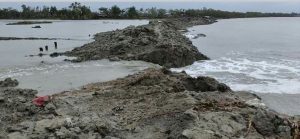
Introduction:
The Sundarbans, the largest mangrove forest in the world, and the 70 lakhs people, animals, inhabit this island, and the environment are in dire straits. Especially Aila in 2009, Bulbul in 2019, super cyclone Amphan in 2020, and recently this year the very severe super cyclone Yaas slammed over Sundarban and flooded the villages, livelihood of people, animal dwellings and the rare Mangroves by breaching the river embankments. The frequent occurrences of the cyclones have imposed difficult situations on the entire ecosystem of Sundarban. We are trying to find out the solution to the problems. We can divide the entire discussion into four divisions:
- What are the obscurities that the people of Sundarban and the ecosystem are facing?
- What can be the reasons for those problems?
- We will try to find out the probable solutions to those problems.
- While searching for the answer we will discuss how we can get benefitted out of the solution and implement the plans.
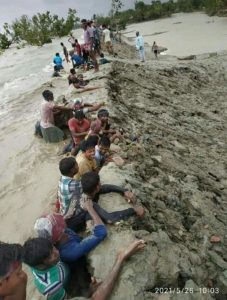
The Current Problem:
- The cyclones that hit the Sundarban once every eight to ten years are now stirring once or twice a year.
- Present river embankments failed to prevent cyclones or tidal surges. As a result, the saline water is flooding the agricultural lands with the human inhabitant lands and it takes two to three years to make the saline water inundated agricultural lands cultivable.
- The saline water after entering the villages is not going back to the rivers naturally causing pain to the people’s lives and livelihood.
- Lots of times, the river changes its course for different causes. For this reason, people have to leave their habitat and farming lands. Again, the transport system is being disrupted due to the emergence of new islands between different waterways
Etiology and Study:
- Natural Causes:
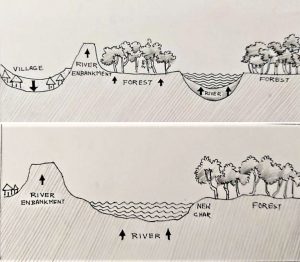
We know that when a river enters its estuary its speed gradually decreases. The sediments the river brings hurled on the riverbed. Particularly in the Sundarbans where small tributaries flow up to 3 to 5 meters of water during the high tide and run off at low tide. The silt carried during high tide is dumped in the riverbed as well as in the riverside. Although this system is very slow, over the years many rivers apparently lose their course and the riverside rise.
- According to the experts, global warming is melting the ice of the two polar areas and is raising the sea levels. The rising water level has flooded many small islands and low lands of coastal areas of Sundarban. According to many people, the reason for the frequent cyclones in the Sundarbans is global warming.
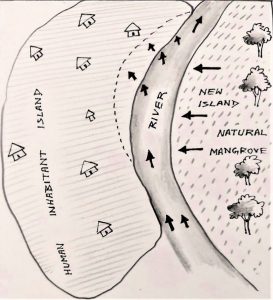
- Reduced river depth and global warming have reduced river navigability. If the cyclone occurs at the time of spring tide or full tide, the earthen river embankments are unable to prevent the tide. As a result, the saline water is entering the villagers either breaching the embankments or overflowing them.
- At different times, the course of the river changes and flows over the land where people live. The root cause of the phenomenon is, hundreds of years ago, to live and cultivate, people surrounded the immature islands of Sundarban with dams. As a result, silt floating in the river water could not enter and make the land hard and high. On the other hand, the outside islands gradually became mature also. This process runs for many years, the river tends to move towards the relatively soft soil where people live which we call “disruption” (Bhangon).
- Human Made Reasons:
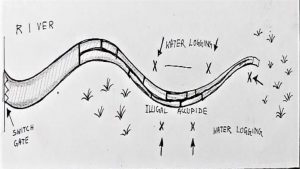
- With time over the years, many small tributaries and canals were confined to make fishery or reservoir for sweet water. During high tide, the water cannot enter these canals. The river has to carry this extra water creating a high-level pressure.
- Fisheries have been made by cutting the mangroves and by acquiring lands in between the river and the river embankment. The dikes of the fisheries are not of good quality but they can resist 80%-90% of tidal waves. But they can’t stand strong against any cyclone. First, these dikes break then the river embankments behind it. The state Irrigation department doesn’t take care of these river embankments where the fishery dikes protect them.
- The best time for repairing the river embankments are from October to March. But most of the time, the repairing work goes on during the rainy season when it is impossible to create a high-quality embankment. Moreover, there is a lack of regular care. In many cases, the deficit can be seen in how the height of the river embankments has been compromised. The immature embankment of soft silt soil cannot withstand the ocean waves due to insufficient mangrove planting or destruction on the river banks.
- In the previous method, the workers would bring soil on their heads and forcefully throw it over the river embankment without the chance of any air bubbles forming. Soil compression would have been very good. But at present soil cutters are being used to repair the river embankment. This method is creating more air bubbles. As a result, river embankments are becoming very fragile.
- The islands inhabited by humans can’t be matured as natural sedimentation is not possible. Slits were used to build houses and roads. In the inner part of the island, ponds were cut and rainwater was collected to cultivate the land. During the rainy season, the slit inside washes out and goes out through the switch gate. These twin effects gradually lower the land. This process we called reverse sedimentation. Almost every island in the Sundarbans looks like a pot that has gone far above sea level.
Proposed Solution:
If we follow the above problems and their causes, we will realize that the root problem of Sundarban is the sediment issue. The silt carried by the river water is sometimes swallowing the river and sometimes the human habitat land is getting lower because of that silt. So, we have to find out the solutions of the sediment first.
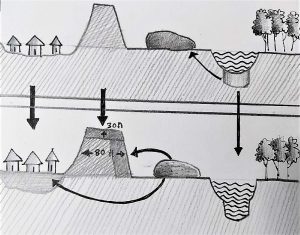
- To increase the water holding capacity of the river, the sediments which are deposited in the riverbed must be cleared by dredging These sediments can be used to strengthen the river embankments and also to elevate the inner lands. This work must be done between October to March. This process will help to keep the course of the river straight and increase the water holding capacity of the river.
- The sediments can be used to make the (30’head, 30’ height, and 80’width) river embankments. Then we don’t need to give concrete bands. These routes need to be used as a major artillery road for transportation. The soil of the embankment will gradually harden which will be able to withstand subsequent cyclones or tidal surges.

3.Where the river has eroded human habitation and is creating river “chars” on the other side, if dredging can be done along the riverbank, then the course of the river will be forced to pass through that channel. The soil collected through dredging can be given for the repairing of the damaged islands. On one hand, there will be no need to acquire land for the construction of new ring dams; on the other hand, the course of the river can be controlled.
4. While making river embankments with a soil cutting machine, arrangements have to be made for good compression. Vetiver grass must be planted along the slope towards the river and two lines of mangrove trees called Geonwa should be planted in the bottom portion of the embankment where the tidal water comes. Cattle do not eat this plant nor it is handy for human use but grows in a very short time. The branches of the Geonwa tree will prevent the storm surges. In addition, mangrove trees should be planted up to a distance of 30 meters from the river.
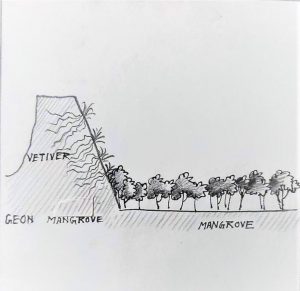 5.On the man-inhabited islands, all roads after river embankments should be considered as backup embankments. If in any way the river embankment breaks and saline water enters, it should be confined to the land adjacent to the river. In case of an emergency, the nearest internal road should act as a second embankment, and the infrastructure should be built accordingly.
5.On the man-inhabited islands, all roads after river embankments should be considered as backup embankments. If in any way the river embankment breaks and saline water enters, it should be confined to the land adjacent to the river. In case of an emergency, the nearest internal road should act as a second embankment, and the infrastructure should be built accordingly.
6.If we can collect the sediments on the riversides villagers can use them for the construction of houses and roads. This will allow the river silt to enter the islands artificially and the islands will be elevated. The process is called artificial sedimentation or siltation.
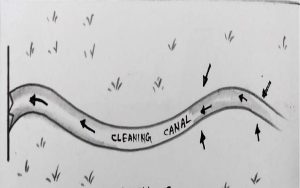
7. During the rainy season many times due to the heavy rain the excess water needs to be drained. With the water tons of sediments also flows back to the river. We have to make the villagers understand to wait for a while. After some days the slit will be set down, and then the water can be cleared. The slit will not go back to the river.
8. Many of the human inhabitant islands of Sundarbans had many small canals that were occupied for private ponds. Renovation of canals according to the old map will improve the drainage system. Otherwise, if for some reason the seawater or the rainwater confines, it will not be possible to get it out.
Outline of plan implementation:
We hope, the irrigation department of the Government will arrange for the removal of the silt from the riverbed. In this case, Government can take the help of the ocean experts or the experts working on the courses of the rivers. Silt and sand are more likely to remove from the riverbed, in which case we will encourage silt to be used for river dams and sand to be used by islanders. In all these processes, along with the use of machinery, it is necessary to take care of the employment of the common man. After the construction of the embankments, we can work with the forest department and local clubs or voluntary organizations to plant grass and mangroves on the embankment slopes. The implementation of the plan is equally important. Arrangements need to be made where, in addition to regular care; even minor problems can be dealt with as soon as possible so that a single problem does not lead to a major catastrophe. This monitoring team will monitor to prevent any illegal fishery in front of the river and to protect the mangrove forests beside the river. We are always ready to cooperate with the Government for the higher interest or development of Sundarban regarding the matter.
Project Activities
- A village for independent and enterprising women (A VIEW) (5)
- About Mukti (4)
- Accreditation (14)
- AGM (63)
- Agriculture Reforms (122)
- Ambulance Service (2)
- Amplifying Community Voices (64)
- Awards (14)
- Awareness and Empowerment (128)
- Awareness drives (52)
- Bio-Village-Kankandighi (10)
- Careers (13)
- Chick Rearing Programme for Marginalised Women (16)
- CHILD (7)
- Climate Resilience River Embankment (46)
- Covid-19 (74)
- Cultural Shows (7)
- Cyclone Aila (13)
- Cyclone Amphan (44)
- Cyclone Bulbul (30)
- Cyclone Dana (3)
- Cyclone Remal (12)
- Cyclone Response & Recovery (90)
- Cyclone Tolerant Houses (15)
- Cyclone Yaas (57)
- Disaster Recovery (264)
- Editorial (50)
- Editorial by Abir Biswas (1)
- Editorial by Amit Kumar Dey (2)
- Editorial by Ananya Chatterjee (2)
- Editorial by Ankita Kothiyal (3)
- Editorial by Debabrata Halder (1)
- Editorial by Dr. Alokananda Ghosh Sengupta (2)
- Editorial by Kasturi Bakshi (1)
- Editorial by Monami Mitra (1)
- Editorial by Nandita (2)
- Editorial by Pampa Karmakar (1)
- Editorial by Pranay Patra (1)
- Editorial by Prof. Pradeep Ray (1)
- Editorial by Ranitendranath Tagore (1)
- Editorial by Sankar Halder (14)
- Editorial by Satyajit Ray (7)
- Editorial by Sohini Mehta (1)
- Editorial by Sonamon Basu (3)
- Editorial by Soumitra Bose (1)
- Editorial by Subhankar Basu (1)
- Editorial by Supriyo Banerjee (1)
- Editorial by Ujjwal Maity (2)
- Education and Enrichment (398)
- Environment and Resilience (126)
- Featured Activities (20)
- Gram Clinic (9)
- Health Water & Sanitation (94)
- HOPE (10)
- Impact Stories List (109)
- Integrated Development (197)
- International Management Institute (IMI) (2)
- Jal hi Kal (6)
- Kitchen Gardening (16)
- Livelihood & Enablement (215)
- MCDF (119)
- Medical Camp (44)
- MIT (8)
- MKSS (47)
- MSS (140)
- Mukti Academia (5)
- Mukti Academy (2)
- Mukti Craft (17)
- Mukti Cultural (2)
- Mukti Employment Exchange (MEE) (9)
- Mukti Fresh (15)
- Mukti Gram - Egra (10)
- Mukti Gram - Purbashridharpur (169)
- Mukti Green Defense in Sundarbans (11)
- Mukti Yoga (12)
- Mukto Dhara (2)
- Northumbria University (2)
- Obituary (6)
- Observance Days Celebration (53)
- Organic Farming & Training Support (44)
- Pond Rejuvenation (20)
- Prerana (1)
- Prerna (4)
- Projects For Mukti Wide (4)
- Queen Mary University of London (1)
- Rights and Special Needs (110)
- Run for Cause (13)
- Run4SafeFood (7)
- SDF (6)
- Shahoshini (9)
- Skill & Enterprise Development (21)
- Smart lab (5)
- Social Stock Exchange (2)
- Social Workers' Convention (1)
- Sundarbans Green (SUN-G) (15)
- Sunderban development fair project (4)
- Surya (8)
- Sustainable Agriculture Movement (62)
- SWAS-2-0 (15)
- Swastha Shongini (31)
- Swavalamban Accelerator in Sundarbans (SWAS) (21)
- Tour for Cause (45)
- TSS (190)
- UDAAN (5)
- Uncategorized (99)
- University of Calcutta (1)
- Value Education (12)
- Valued Partners (3)
- Vocational Trainings (15)
- VOICE (14)